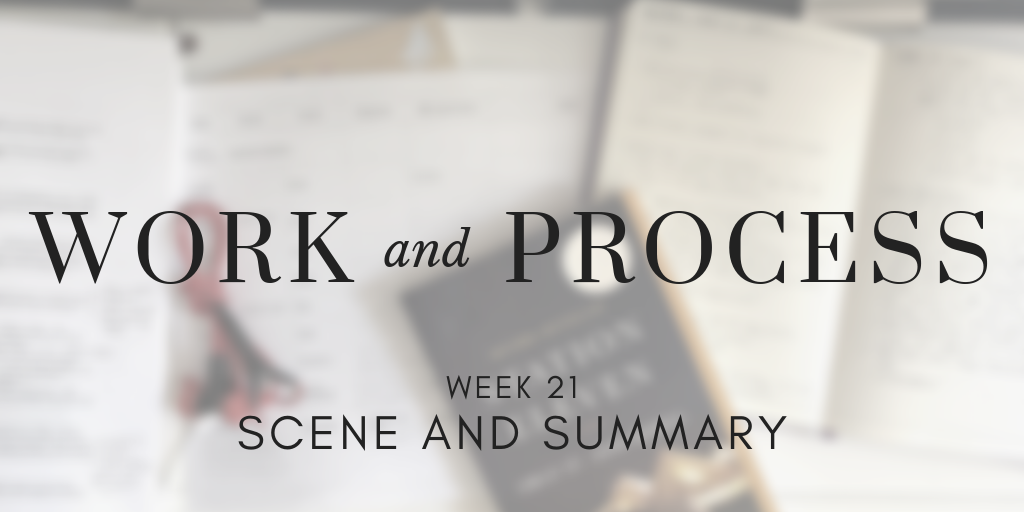|
I did it again. I said I’d talk about significant concrete detail this week, and now I’m talking about something else. That’s because as soon as I started trying to talk about significant concrete detail, I realized that I first needed to address a different topic: the difference between scene and summary. You may have heard the advice, “Show. Don’t tell.” I suspect it’s intended to mean: use description and action to write an immersive scene, rather than explaining to the reader what’s going on and what’s at stake, as if you were a lecturer rather than a storyteller. But ultimately, this is one of my least favorite pieces of writing advice, because it ends up being so reductive. “Show. Don’t tell.” means you get long paragraphs of description about, what, a room? A person’s clothes? An action sequence? These things can be compelling, of course, but strict adherents of “Show. Don’t tell.” tend to linger on these inconsequential details, making them seem drawn out and even boring, rather than getting a move on with the story. That said, what I find more useful than “Show. Don’t tell.” is a discussion of scene and summary. You might be able to recognize these as soon as you see them. Scene is where it feels like you’re actually there with the characters. The writer includes descriptions, dialogue, actions, and even if the passage written in the past verb tense, it still kind of feels like it’s all unfolding or happening as you read it. (You could say it’s “showing,” but like I said, I’m trying to get away from that paradigm.) Summary, on the other hand, is where big pieces are quickly (relatively, anyway) skimmed over. These passages can feel like a montage, or a jump in time, or a recap of something that’s already happened somewhere else. It feels like a recounting of an event, rather than the event actually happening in real time. Do you remember those scenes in Ant-Man where Michael Peña’s character, Luis, tells Ant-Man a quick-ish anecdote? That’s summary. (You could also say this is “telling,” but you know how I feel about that.) I’d say that in general, the bulk of a story is often made up of scenes (although pieces like "Brokeback Mountain" by Annie Proulx use summary in breathtaking ways, covering years of information in a few sentences or a paragraph). Scenes, in general, keep the reader in the story, if that makes sense, while summary is used to give readers information they need, but that they don’t need to see happen before their very eyes. Someone’s great uncle keeled over at dinner one night, so the main character has inherited a vast sum and now needs to figure out how she’s going to live the rest of her life? Great opportunity for summary. We don’t need to see the uncle’s death if the story isn’t about the uncle or his death but about what the main character is going to do with the money now. The characters go to bed? Great. We don’t need to see their extensive night time rituals. We can just be told, “Occupied by their separate thoughts, the family retired to their separate bedrooms for a restless night of sleep,” and move on to the next scene. What I love about scene and summary (as opposed to “Show. Don’t tell.”) is that they both have their places, and their places are almost never totally separate. Writers flip back and forth between scene and summary all the time. For example, let’s look at this passage from A Shadow Bright and Burning, the first book in a rollicking good read of a YA fantasy series by Jessica Cluess: The sorcerer guided Sarah to a chair while I remained by the wall, invisible as always. Schoolteachers don’t stand out naturally, and I was far too thin and dark-haired to make much of an impact. Granted, I didn’t want to stand out to Agrippa today, not if he’d come about the fires. I exhaled, praying that my heartbeat would slow. Please say that he had come for some other reason. The scenery, the terrible April weather, anything. I love how Cluess jumps effortlessly back and forth between scene and summary here, weaving them seamlessly to keep us in the present storyline while also providing background information necessary to our understanding of the story and characters. SCENE: It’s as if we’re watching these actions unfold: the sorcerer and Sarah in movement; the main character, Henrietta, standing still, unnoticed: The sorcerer guided Sarah to a chair while I remained by the wall, invisible as always SUMMARY: Then the narration switches to exposition, revealing, I think, how Henrietta conceives of herself at the beginning of the novel, before the start of her adventure: Schoolteachers don’t stand out naturally, and I was far too thin and dark-haired to make much of an impact. SCENE: And just as quickly, Cluess pops us back into the room with Henrietta, the sorcerer, and Sarah. The narration remains in her head, but it’s concerned with what’s happening right now, emphasized by Henrietta’s focus on her breath and heartbeat: Granted, I didn’t want to stand out to Agrippa today, not if he’d come about the fires. I exhaled, praying that my heartbeat would slow. Please say that he had come for some other reason. The scenery, the terrible April weather, anything. If a fervent believer of “Show. Don’t tell.” were writing this story, they might belabor Henrietta’s inconspicuousness, going into excruciating detail about exactly how and why she fades into the background of this scene. But summary, coupled with the very voice-driven statement “invisible as always” (which in itself might be considered a form of “telling,” I suppose, but the “as always” has such wonderful hints of both resentment and resignation to it, “showing” that while Henrietta may consider herself “invisible,” she isn’t necessarily content with it, thus creating tension between who she considers herself now, who she wants to become, and how she navigates the path between them), achieves the same effect in a more efficient way. Both scene and summary (or “showing” and “telling”) are such great tools for a storyteller, and they serve different purposes (although, of course, I advocate trying to use them for totally different purposes, too, just to see if you can). I don’t see any point in ignoring one of the tools in your toolbox when you could, instead, try everything. Get comfortable with ways to incorporate both scene and summary into your work, and then, if you’re so inclined, get bold. These are your tools, after all. How else can you use them to tell a good story? Next week: SIGNIFICANT CONCRETE DETAIL. No, really! Next Sunday at tracichee.com and/or post your own responses with the hashtag #workandprocess. It’s already been written, I promise! <3 Work and Process is a year-long journey of exploring and reflecting on the artistic process, craft, and working in a creative field. Each Sunday, I’ll post some thoughts, wonderings, explanations, and explorations on writing and creativity, and by the end of it, I hope to have 52 musings, examinations, meanderings, discoveries, bits of joy or inquisitiveness or knowledge to share. In each post, I’ll also include a topic for the following week, so if you happen to be inspired to question/wonder at/consider your own work and process, you’re welcome to join me. We’ll be using the #workandprocess hashtag across all social media platforms, and I hope we find each other to learn and connect and transform on our creative wanderings. Comments are closed.
|
ARCHIVES
February 2024
CATEGORIES |


 RSS Feed
RSS Feed